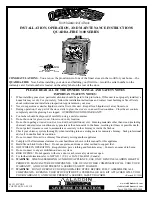
54
VENTING SYSTEMS
National Building Codes require venting of systems that burn solid and liquid fuels. Approval and listing agencies define
venting as the means for removing the flue gases from a facility’s equipment that burns solid or liquid fuels to the outside
atmosphere. Further, these agencies state that venting systems shall be engineered and constructed in order to ensure a
positive flow of air adequate to remove the flue gases to the outside atmosphere. Venting and the requirements associated
with venting thereby define the chimney systems that are ultimately designed for each solid fuel-burning stove or
fireplace.
There are only two methods (with many variations) to build proper venting systems for solid fuel (wood burning) systems:
a) prefabricated chimney systems as shown in FIGURE 27 or b) masonry chimney systems as shown in FIGURE 28.
FIGURE 29: FREESTANDING PREFABRICATED CHIMNEY SYSTEM (no chase)
Whichever system the homeowner chooses to have installed, chimney systems are expensive. These parts of a heating
system are effective at removing exhaust gases for decades or they repeatedly fail at their function, cause problems, and
create expense. Cut corners on installation or scrimp on costs and the chimney system will become a source of
nightmares. In the chimney business, no matter how expensive it is to do it right the first time, it is far less expensive than
doing it over. Almost 30 years of manufacturing experiences has taught Country Flame that if there is one-place
customers must be vigilant and become knowledgeable, it is in ensuring a chimney system is properly engineered,
designed and installed to match the heating stove being installed in their home.
Summary of Contents for Catalytic BBF Series
Page 4: ...4 SAFETY NOTES 2 3...
Page 29: ...29...
Page 49: ...49 FIGURE 24 GOLD DOOR WARNING LABEL FIGURE 25 EPA STOVE STICKER...
Page 50: ...50...
Page 51: ...51...










































